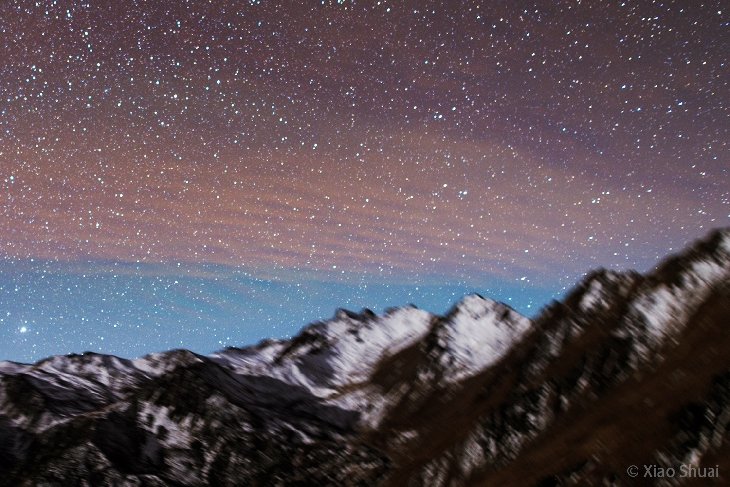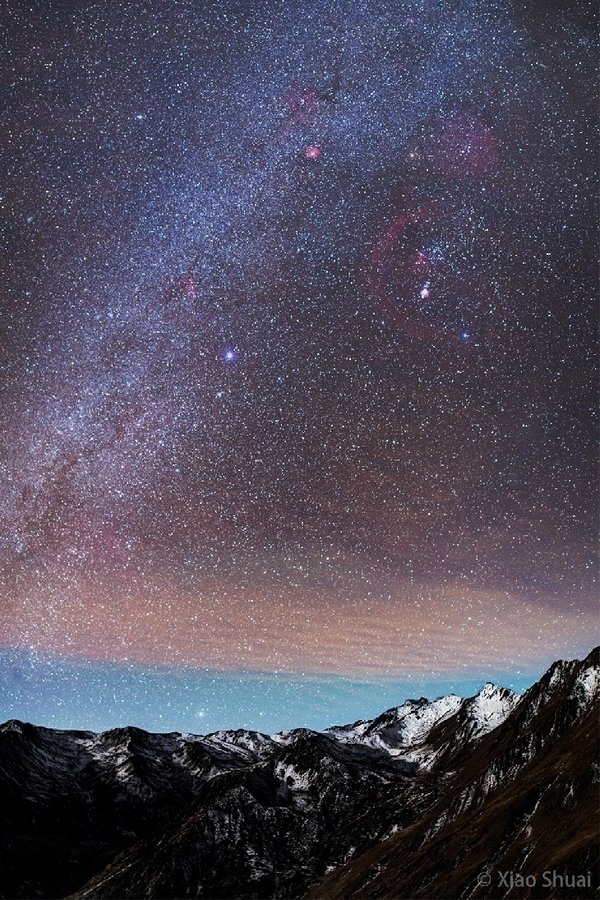MESOSPHERIC BORE (IT'S NOT WHAT YOU THINK)
This month, a lot is happening in the mesosphere. The mesosphere is a layer of Earth's atmosphere above the stratosphere; it is the realm of sprites, noctilucent clouds (NLCs), and airglow. Starting on Nov. 17th, NASA's AIM spacecraft spotted bright noctilucent clouds forming in the mesosphere above Antarctica. Then, in an apparently unrelated development on Nov. 24th, the normal dome of airglow over China split in two.
Comment: Meanwhile down below between 17th and 25th November there were strong earthquakes occurring: Strong 6.4 magnitude earthquake strikes Argentina, 7.3 Magnitude earthquake off Fukushima triggers tsunami warning, Magnitude 6.5 earthquake hits northeast Tajikistan, Tsunami warning lifted in El Salvador and Nicaragua after 7.0 magnitude earthquake strikes in Pacific Ocean
Xiao Shuai photographed the event from Mount Balang in Sichuan:
This is called a "mesospheric bore"--and not because it's dull. A bore is a type of atmospheric wave with deep ripples at its leading edge. Indeed, you can see the ripples in Shuai's photo separating the zone of airglow from clear sky.
Bores fall into the category of "gravity waves"—so called because gravity acts as the restoring force essential to wave motion. Analogy: Boats in water. When a boat goes tearing across a lake, water in front of the boat is pushed upward. Gravity pulls the water back down again and this sets up a wave.
In this case, instead of water, rarefied air is the medium through which the wave propagates. The sudden boundary in the airglow layer is probably akin to a hydraulic jump. But what created the disturbance in the first place? (What is the 'boat'?) No one knows.
Details: A mesospheric bore was captured from Mount Balang, Sichuan, China on November 24. The photographer reported that it was seen with naked eye. The direction of these photo were toward south and the foreground mountain was illuminated by the rising 25th moon.
Location: 30°5354''N and 102°5403E.
Time: November 24th, 2 A.M - 4 A.M (GMT +8)
This propagating sudden brightening or darkening of the nightglow followed by a train of waves is called the mesospheric bore. This phenomenon occurs at ~90 km high. Its associated with the hydraulic jump of the airglow layer. Scientists speculate that this phenomenon is caused by atmospheric gravity waves trapped inside a temperature inversion layer." Dr. Yue Jia, a research scientist at Hampton University, University of Maryland College Park and NASA Goddard Space Flight Center explained.
"There may be updates in the coming days as scientists from NASA and the Chinese Academy of Science check data from satellites to learn more about this event," says Jeff Dai, who has been helping Xiao Shuai process and communicate his extraordinary images. "Also, we encourage other photographers from Thailand, Myanmar, Bangladesh and India to submit their images of the wave."
There maybe more update in the coming days. As scientists from NASA and Chinese Academy of Science will check the data from S-NPP DNB Satalite and All sky airglow






Comment: For more strange happenings on the planet see: SOTT Earth Changes Summary - October 2016: Extreme Weather, Planetary Upheaval, Meteor Fireballs